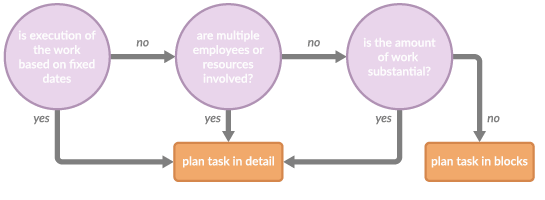Detailed planning: When should you plan in detail?
If you create many small tasks and include in your planning, you can end up “blowing up” you planning. The risk is that you will end up spending your entire day on updating your planning, especially in a dynamic environment that requires many changes. This blog will explore what alternatives there are and what factors determine whether you should plan in detail or not.
Just to make things clear, we need to explain the type of work that we are discussing. We are not talking about project based work, as tasks in a project will always be part of the project planning. We are talking about all kinds of activities that need to be carried out by employees on an ad hoc basis. Or small changes to a design as a result of feedback from customers, which needs to be done on the fly.
What is a detailed planning?
A detailed planning is a planning build up out of small tasks. When taking a look at our customers we find that in general, an unit of half an hour is considered small. If you use half an hour as a measurement unit, then you have a theoretical maximum of 16 units per employee per day. A company with 25 employees, would have access to 400 units per day and 8000 units per month. That’s a lot of units to plan and control, especially if the planning changes often.
Planning is not an exact science. The aim behind planning is to estimate future work, and we would like to emphasize the word “estimate”. Reality however, is not easily estimated. Not a single plane will exactly follow the charted course. There are continuous deviations, as circumstances will change during the flight, and cannot be predicted. The course (or the planning) is only a tool used to arrive at the destination.
The moment you start with detailed planning, it becomes easy to lose sight of the goal. The focus will be on predicting and controlling all the work. This might satisfy the control freak, but planning all those items will become a job in and off itself, which is not what we wanted to achieve. Planning is not a goal, it’s only a means to a goal.
The alternative: Planning in blocks
The alternative is to plan all those small tasks as a single block. One or more four hour blocks are planned per week and you request an employee to work on the block containing all the small tasks. It’s important to bundle all those small tasks, as picking them up between other activities, is multi-tasking, which leads to time-waste. Please take a look at our blog on the 4 time wasters in project planning.
How will you know that for instance, 4 hours is enough? Based on experience, people will usually be able to make an estimate of how much time they need for all those small tasks. Are you unable to make that estimation? Build an experience database via time-writing. By requiring employees to register the hours they spend on these tasks for a couple of weeks, you will be able to have clear insight into the average time spend on these tasks. This input can be used to determine the time span of the “blocks” which can be used in creating an effective week planning.
You will find that time-writing requires registration on task level. The registration will often be required for invoicing based on costing price agreements. Even if you make use of fixed prices or service contracts, you will still want to know whether or not you are still within budget.
Is planning in blocks always the best approach? No, it’s not. There definitely are some small tasks which cannot be planned in a block and require you to plan them on task level. It will depend on the situation.
Deciding factors
The main question is: When do you make a planning using blocks? There are three deciding factors:
- Is execution of the work based on fixed dates?
- Are multiple employees or resources involved?
- Is the amount of work substantial?

The first factor shows whether or not a concrete agreement regarding start/end times is in place. These are hard requirements that determine the period within which the tasks needs to be carried out. An example would be changes to a webpage that need to be done at night, to make sure that visitors will not be hindered.
The second factor determines whether coordination is required between employees or tools. An example would be a half-hour photo-shoot where a photographer, an assistant and a photo booth are required at the same times. The use of all these resources needs to be planned, as they might not all be available at the same time.
The third factor determines how substantial the work is. Is it a 4 hour task? Then it makes sense to plan it individually. Does the task require less time or is it not known how much time is required? Then plan the task as part of a block, combined with other tasks.





